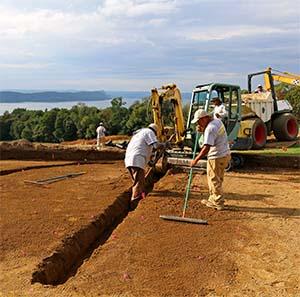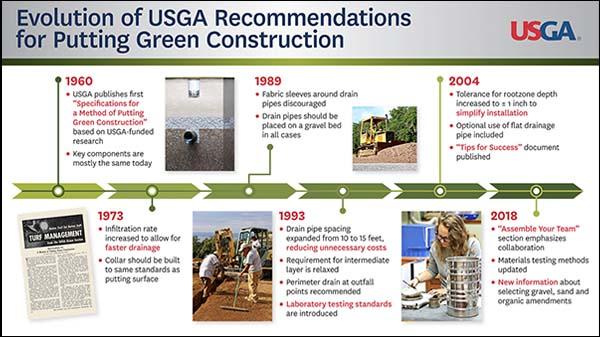The USGA's Bible for building putting greens is hardly a static document.
In fact, since it was first published in 1960, the USGA Recommendations for a Method of Putting Green Construction is a dynamic script that has been amended five times, including its most recent update in 2015.
 "The purpose of the revisions process is to go through all the research that is being done and see if any new techniques or materials need to be included in the Recommendations to make them more reliable," said Adam Moeller, director of USGA Green Section Education. "We also want to make sure that the Recommendations are still an industry standard that can work anywhere in the world.
"The purpose of the revisions process is to go through all the research that is being done and see if any new techniques or materials need to be included in the Recommendations to make them more reliable," said Adam Moeller, director of USGA Green Section Education. "We also want to make sure that the Recommendations are still an industry standard that can work anywhere in the world."The bulk of the Recommendations are the same. This is the fifth set of revisions, and the least amount of revisions since the recommendations came out in 1960."
Key changes in the latest set of revisions, Moeller said, are about selecting gravel, perimeter drains, clean-up ports, clarifying rootzone mixtures and new information on amendments used in a rootzone mix.
Green Section director Kim Erusha, Ph.D., Darin Bevard Green Section director of championship agronomy, and Mike Kenna, the group's director of research, ran point on the project that has been in the works for nearly two years.
Staffing changes and the retirement of former research director Jim Moore slowed the process. The revised document was written by turf and soils consultant and 2017 USGA Green Section Award winner Norm Hummel, Ph.D. Hummel also authored the revised document after changes in 1993 and 2004.
Other changes occured in 1973 and 1989.
The section on drainage includes advice on adding perimeter drains at any low point along the perimeter wall, and no longer just at the terminal point. The drainage section also now recommends installing clean-up ports on high and low side of putting green drainage lines, so cameras can be used to inspect the area.
"A lot of people were already doing this in the field," Moeller said. "We thought it was time to include it in the Recommendations."
Pertaining to gravel, the USGA now says research indicates there is evidence that placing low-pH rootzone mixtures over high-pH gravel materials such as limestone and dolomite contributes to the formation of iron-oxide layers at the rootzone and gravel interface. These layers have been shown to impede drainage from the rootzone mixture to the gravel layer. If given the option, selecting a neutral-pH gravel is recommended.
"This iron-oxide layer is almost cemented together," Moeller said. "It can be a quarter-inch to a half-inch thick. Certainly research and work in the field indicate there is a concern this can impede water drainage into the gravel and the drainage below."
Finally, the new version of the Recommendations provide tips on selecting amendments for the rootzone mix.
The Recommendations also includes the supplemental guide entitled Building the USGA Putting Green Tips for Success. This document, Moeller said, goes through all the steps outlined in the Recommendations and does so in more depth.
"There is no set time frame to update the Recommendations," Moeller said. "If something needs to be done sooner than in that 10-year mark, we can certainly do that. It's not like the Rules of Golf that change every four years, and I think that is a testament to the science that backs the construction method."


